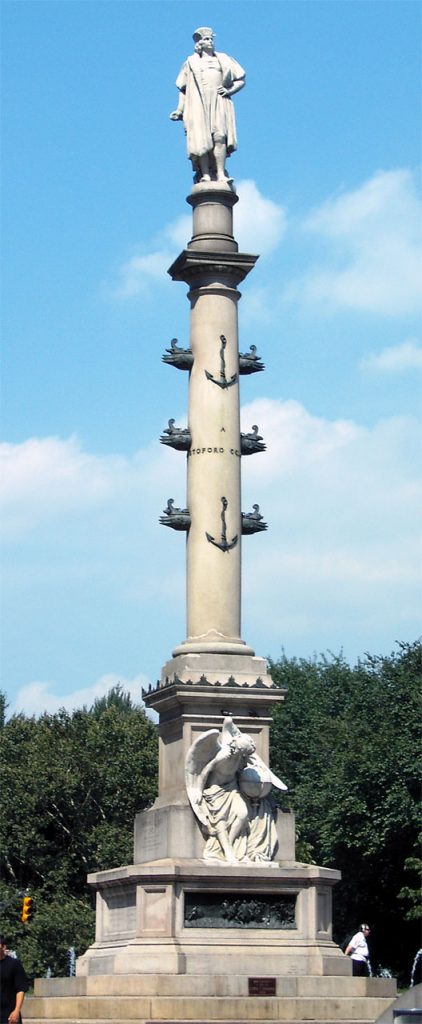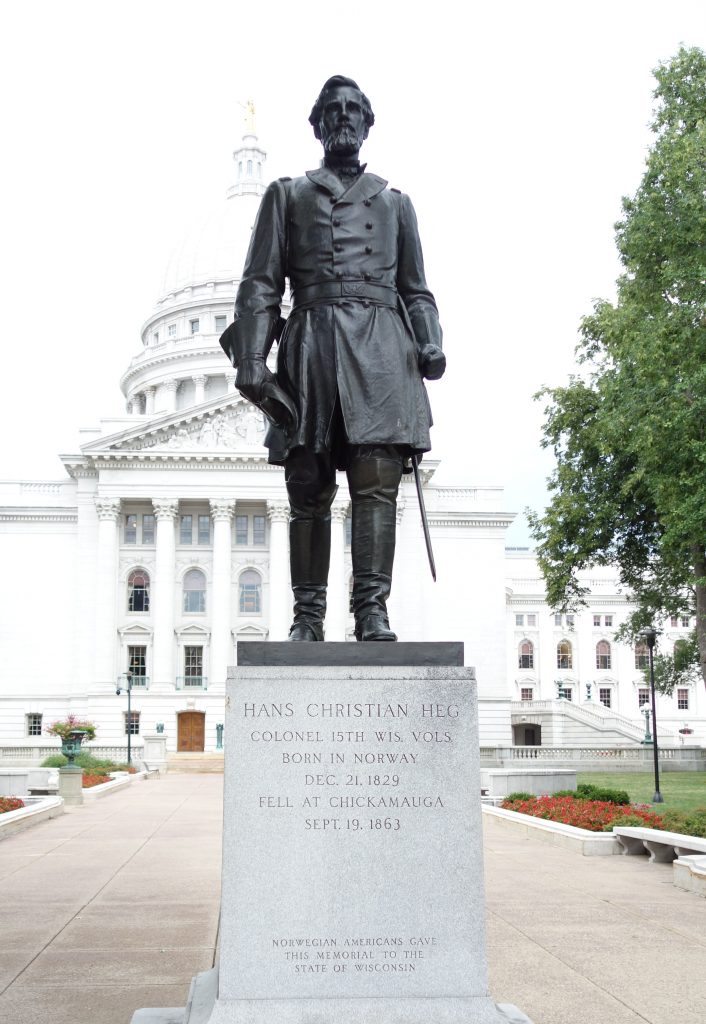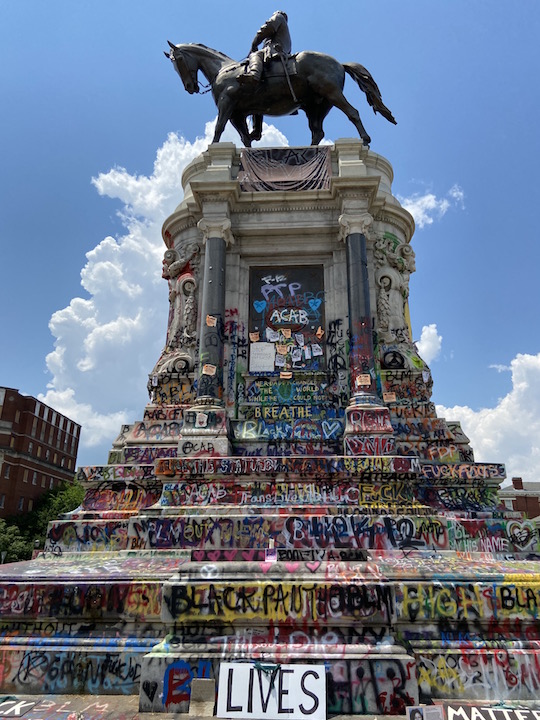BY BILL WEINBERG | The sight of statues of Confederate generals and slavocrat politicians coming down in several states across the country is a long-overdue correction.
There is no ambiguity on what those monuments to Robert E. Lee, Jefferson Davis and John Calhoun represented. These men stood in life for the most oppressive white supremacy, and their images were raised after their deaths as proud signifiers that the fundamentals of white supremacy remained intact despite the Civil War and Reconstruction. These monuments were raised as ritual intimidation and humiliation of African Americans.
Now, things are being taken to the next level, with statues targeted for removal that have racist content or historical associations but are not of figures who fought for slavery or the Confederacy, and were not raised as an intentionally threatening message to Blacks. And the question has reached New York City.
Memorializing mass murderers, celebrating slavers
I was certainly happy to learn that the equestrian statue of Teddy Roosevelt that stands outside the American Museum of Natural History is to be removed. Whenever I went to the museum as a kid, passing that statue annoyed me — the Great White Father mounted on a horse, while the African (whose people had been enslaved) and the Native American (whose lands were stolen) walk semi-clad on either side, slightly to his rear, their heads level with his rump. An unambiguous testament to America’s racial hierarchy. (And that was before I knew of TR’s campaign of massacre in the Philippines.)
There is also a push to remove the Thomas Jefferson statue from City Hall. Jefferson expressed anguish about slavery in his “Notes on Virginia,” which may have been genuine — but he was still the “owner” of more than 600 human beings during his lifetime. As governor of Virginia during the War of Independence, he also dispatched a militia force to attack the Shawnee indigenous people in the “Northwest” (present-day Kentucky and Ohio).
The statue of George Washington on the arch in Washington Square was pelted with red paint this week. Washington, of course, was also a major slaveholder. Ironically, while never grandstanding against slavery in life as Jefferson did, he did free his human “property” in his will — again, unlike Jefferson. In a little-known sideshow to the War of Independence, he also waged a campaign of ethnic cleansing against the indigenous Iroquois Confederacy on New York state’s western frontier. His troops burned so many villages that the Iroquois dubbed Washington “Town Destroyer.” Sullivan St., which runs into Washington Square on the south, is named for the leader of this brutal campaign, General John Sullivan.
Lower East Side Democratic District Leader Paul Newell is likewise calling for a purge of monuments to Peter Stuyvesant — noting that he was “New Amsterdam’s largest slave owner.”
And, inevitably, there are calls to remove the statue of Christopher Columbus that towers over the circle that bears his name at the southwest corner of Central Park. This is meeting equally inevitable resistance from leaders of the city’s Italian American community. And here is where things start to get complicated.
Contested Columbus
Columbus has become a symbol of conquest and genocide. His rule in Hispaniola was one of enslavement and massacre of the island’s Taino indigenous people. It is for good reason that dozens of cities and states — including Vermont, Minnesota, Oregon and Alaska — have replaced Columbus Day with Indigenous People’s Day.
But the statue at Columbus Circle was not raised as a conscious denigration of Native Americans. On the contrary, it was raised as a symbol of dignity for Italian Americans —or, viewed more cynically, of their aspiration to become “white” at a time when they were still stigmatized by white society.
In 1891, the year before the statue was raised, 11 Sicilian immigrants who had been acquitted of murdering the police chief were lynched in New Orleans — one of the largest mass lynchings in the country’s history. (Teddy Roosevelt in a private letter referred to the lynchings as “rather a good thing.”)

The following year, the 400th anniversary of Columbus’s landfall, New York’s Italian community raised money for the statue and petitioned to have it raised. Columbus became the icon of Italian American social ascendance — despite the fact that he never reached the shores of what is now the U.S., and he sailed for Spain not Italy (which did not even exist as a nation-state then). The raising of Columbus monuments at that time was bitterly opposed by the Ku Klux Klan, who were (of course) the very last to accept the Italians as “white.”
The urge to purge: Uses and abuses
Acknowledging the cultural complexities around some of these contentious statues is not a defense of the statues per se. There is a part of me — a survival from my hotheaded anarchist youth — that wants to see all statues overturned, because they represent the Cult of Great Men, as Karl Marx put it, the “shadow of dead generations that weighs like a nightmare on the brains of the living.”
Another statue that I took great glee in hating as a young (and naive) rad was the one of Poland’s medieval King Jagiello in Central Park. I thought it repulsive that there should be a statue of a feudal monarch in a modern city. It was only years later that I became aware of the antifascist symbolism of that statue — Jagiello had fought the Teutonic Knights, and his monument was raised in 1939, when Poland was invaded by another German aggressor, the Nazis.
It was also only later that I learned of the pathological extremes to which the urge to purge images of an oppressive past were taken in China’s Cultural Revolution, in which countless Buddhist artifacts were smashed.
Abetting revisionism?
I felt signals of misgiving with the news that a statue of Ulysses Grant had been torn down in San Francisco on Juneteenth. Not that this was necessarily unjustifiable. Grant (from free-soil Ohio) married into a slaveholding Missouri family, and it is an irony that he was the last U.S. president to “own” an enslaved human being. But I do hope that the protesters who tore down his statue understood that that this is, in fact, an irony. For those who know the history, there is an inherent paradox to tearing down a statue of Grant on Juneteenth.
As president, Grant also continued the project of subduing the Native Americans and usurping their lands, launching the Great Sioux War (whose most reviled general was George Armstrong Custer) and the Modoc War in Northern California. He also appointed the first Native American as Indian commissioner — Ely S. Parker, a Seneca (one of the Iroquois nations) from Upstate New York, who struggled as best he could to restrain prosecution of the Indian Wars.
There have been other such paradoxical statue attacks. Days before Juneteenth, a statue of poet John Greenleaf Whittier in the California town that bears his name was scrawled with “BLM” and “FUCK SLAVE OWNERS” — despite the fact that he had been a prominent abolitionist, not a slave “owner.”
And days after Juneteenth, protesters in Madison, Wisconsin, toppled a statue of Hans Christian Heg — a Norwegian immigrant who was an ardent antislavery activist, and who died in battle as a Union colonel in the Civil War.

So there’s a part of me that shares the nihilist imperative to destroy an oppressive society’s self-congratulatory (at best) monuments to itself. But there is another part of me that heeds alarm bells about a rewriting of history that may play into the hands of our worst enemies.
Racist reactionaries now fly the Confederate flag in places like Wisconsin and Michigan and Upstate New York. Are they actually ignorant that their own states had been on the Union side? Do they buy (or pretend to buy) the Southern revisionist line of “heritage not hate,” the deluded notion that the Civil War was not about slavery but “states’ rights”? In either case, there may be some on our side who abet (if unwittingly) this ignorance or revisionism, by portraying the Civil War in morally neutral terms. Because — however much the Northern industrialists were its ultimate beneficiaries, and however much the advances of Emancipation and Reconstruction were reversed after the withdrawal of Union troops from the South in 1877 — the Civil War was by no means morally neutral.
Patronizing presentation
Then there are at least two statues of Abraham Lincoln himself that protesters are demanding be removed — the Emancipation Memorial in Washington, D.C., and its replica in Boston. What is at issue here isn’t Lincoln himself, but the position of the freed Black portrayed in these monuments — literally on bent knee, fawning in gratitude (and, again, semi-clad).
Defenders of the statue point out that it was actually erected by emancipated Blacks, with money they raised themselves, and Frederick Douglass officiated at its unveiling in 1876 (with President Grant in attendance). And it is a fact that the image of a chained, kneeling and semi-clad Black man was a symbol of the abolitionist movement — generally accompanied by the phrase “Am I not a man and a brother?” It is also true that Douglass, in his comments that day, acknowledged Lincoln’s own conflicted legacy — he had fought the Civil War, first and foremost, to preserve the Union, not to end slavery.
There is a monument in New York that shares this identical problem of presentation — the statue in Brooklyn’s Cadman Plaza of Henry Ward Beecher, the famous abolitionist preacher. The white savior is literally on a pedestal while Blacks literally fawn at his feet, below the pedestal. Beecher, the pastor of Brooklyn Heights’ Plymouth Church, was a favorable historical figure. But obviously the statue, raised in 1891, betrays an ugly, patronizing racism. If it hasn’t yet drawn the ire of the protesters, it certainly will.
So, what do we do with this statue? Do we tear it down as a racist artifact? Do we leave it up, but add some interpretive material noting that it reflected the backward values of the time it was raised? Or do we just leave it alone, and accept that most people are smart enough to view it in historical context?
Or, do we counterbalance these monuments with new, more dignified ones, to the icons of Black self-emancipation: Frederick Douglass (who now stands at the side entrance to the New York Historical Society on 77th St., second place to Lincoln at the front entrance on Central Park West, and also at 110th St. and Eighth Ave. outside Central Park), Harriet Tubman, Sojourner Truth, the Black regiments in the Union Army, even (dare we imagine it?) Nat Turner?
The final dilemma
And a final dilemma — what do we do with the statues, even of the most egregious Confederates and slavocrats, after they come down? Do we destroy them, as the statues of King George III were destroyed in New York and Philadelphia in 1776, and those of Lenin and Stalin were destroyed in East Berlin and Budapest in 1989?
Or do we put them in museums, as cultural artifacts? We don’t have statues of Hitler in public places, but we do have a Holocaust Memorial Museum, where his legacy is documented for posterity. Maybe the monuments to white supremacy should be placed in the National Museum of African American History & Culture — or a new Museum of American Slavery & the Middle Passage.
But there is a danger here, too — that even in such a context, the statues could become sites of veneration for white supremacists. After Taiwan’s democratic transition in the 1990s, the ubiquitous statues of the late dictator Chiang Kai-shek around the country were relocated to the park where his mausoleum stands— now a site of perverse pilgrimage by his nostalgic devotees.
The long-delayed reckoning with the legacy of American racism inevitably raises quandaries and contradictions. The more seriously we grapple with these questions, the more profound and meaningful the reckoning will be.
Weinberg blogs at CounterVortex.org.


[…] This story first appeared July 2 in The Village Sun. […]
Excellent. Let’s keep discussing and thinking about ALL THIS. I like the previous comments also.
What? No mention of Marcus Garvey and the park named after him in Harlem? Garvey was such an extreme black separatist that he advocated not for integration but that American blacks return to Africa. He envisioned the African continent as one nation, governed, naturally, by himself. This “return to Africa” view was shared by the KKK, with whom Garvey collaborated and who shared his opinion of racial separatism (and anti-Semitism as well). He met with the Imperial Wizard of the KKK in Atlanta in 1922.
After a jury convicted Garvey of mail fraud, he shouted abuse in the courtroom and calling both the judge and district attorney “damned dirty Jews”.
In 1928, Garvey told a journalist: “When they wanted to get me they had a Jewish judge try me, and a Jewish prosecutor. I would have been freed but two Jews on the jury held out against me ten hours and succeeded in convicting me, whereupon the Jewish judge gave me the maximum penalty.”
So why is there a park in Harlem named after this racist, anti-Semite?
Bill. Thank you for doing a great job of bringing a host of metal castings to life and helping us to reckon how to deal with a very difficult subject. There is nothing inherently wrong with signifying our common victories with giant memorials but there is also the guarantee of our passivity through the exaggeration of the role of the few rather than the many. Russia and China both promoted artworks that gave full credit to peasants and workers for their achievements and sacrifices, but still put their leaders on enormous pedestals in every major city at the same time. We do the same thing by deifying musicians, who are allegedly speaking on behalf of all of us, while they flaunt their wealth and outrageous lifestyles, in contrast to the widespread poverty and despair which surrounds them. The vast majority of those using the streets as a megaphone to broadcast their intentions are looking for creative ways to reverse some of our historical mistakes and ignorance of important facts and not to be destructive. We should be grateful that we now can put the grand monuments that litter our public spaces in the proper perspective, informed by the realities of their lives and not blinded by their magnificence.
Most statues stand in sunny, open locations where a tree or large plant could be put in a planter. A plaque could inform people about the plant, its history, uses and connection to the area. The municipality could employ someone to take care of if. Metal statues can be melted into attractive planters. The current social justice movement seldom includes climate change in its platforms.
Further, Abraham Lincoln was a white supremacist. He said so himself in Charleston, Illinois on Sept. 18, 1858. “…I am not nor ever have been in favor of making voters or jurors of negroes, nor of qualifying them to hold office, nor to intermarry with white people; and I will say in addition to this that there is a physical difference between the white and black races which I believe will forever forbid the two races living together on terms of social and political equality. And inasmuch as they cannot so live, while they do remain together there must be the position of superior and inferior, and I as much as any of her man am in favor of having the superior position assigned to the white race.”
Enough with the stupid statues and people’s faces on money. The fate of public art should be voted on by the public. If that takes too long let the vandals improve these boring hunks of junk with paint, hammers, chains, wrecking balls or, better yet, chia seeds.
Excellent!